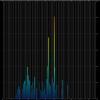Perhaps we should differentiate the topic a little more.
Is 5% distortion is audible at 50Hz@85dB, most likely not. At 1kHz@85dB for a music signal with little possibility of sound masking, very likely yes.
Furthermore, one should always be aware that distortions are non-linear when the sound pressure increases. This means that even with a small increase in sound pressure, the distortions can literally "shoot into the sky". Therefore it makes sense to have a buffer that is as "big as possible".
Depending on the music material, a floorstanding loudspeaker in a large room can be required to provide well over 100dB@1m for a short period of time, which can result in double-digit distortions for some speakers.
If music material provides little masking and is more like an artificial two-tone or multi-ton test signal, the threshold for distortion drops dramatically. With an artificial two-tone test, even 0.3% distortion can be perceived by listeners.
At a piano concert, a piano keystroke can be more than 30dB above average - e.g.
Heather Pierson - When You Wish Upon A Star
View attachment 58715
In this case you would have to look at the masking effects of a single tone.
Source:
https://de.wikipedia.org/wiki/Maskierungseffekt
(Drawing is only available in the German version)
View attachment 58717
At 80dB of the noise signal (in our case, this would be the piano keystroke at 1kHz), HD2 (second order harmonic distortion at 2kHz) would be masked up to about 40dB (1%). HD3 would only be masked up to about 30dB (0.3%). The orange masking curve with the number 80 applies.
Or think of a jazz trio with piano, for example by
the ingenious Ray Brown Trio. Here too, the music material provides only a few masking possibilities for resulting distortions.
View attachment 58716
My recommendation (as always

):
Try the Klippel hearing test or just install a sine wave generator and do different tests yourself.
http://www.klippel.de/listeningtest/?v=3



